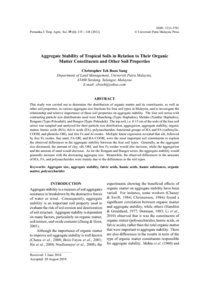Citation
Teh, Christopher Boon Sung
(2012)
Aggregate stability of tropical soils in relation to their organic matter constituents and other soil properties.
Pertanika Journal of Tropical Agricultural Science, 35 (1).
pp. 135-148.
ISSN 1511-3701; ESSN: 2231-8542
Abstract
This study was carried out to determine the distribution of organic matter and its constituents, as well asother soil properties, in various aggregate size fractions for four soil types in Malaysia, and to investigate therelationship and relative importance of these soil properties on aggregate stability. The four soil series withcontrasting particle size distributions used were Munchong (Typic Hapludox), Melaka (Xanthic Hapludox),Rengam (Typic Paleudult), and Bungor (Typic Paleudult). The top soil, i.e. 0-15 cm of the soils of the four soilseries was sampled and analyzed for their particle size distribution, aggregation, aggregate stability, organicmatter, humic acids (HA), fulvic acids (FA), polysaccharides, functional groups of HA and FA (carboxylic,COOH, and phenolic-OH), and free Fe and Al oxides. Multiple linear regression revealed that silt, followedby free Fe oxides, fine sand, FA-OH, and HA-COOH, were the most important soil constituents to explainthe observed differences in the aggregate stability between the four soil types. Generally, as the aggregatesize decreased, the amount of clay, silt, OM, and free Fe oxides would also increase, while the aggregationand the amount of sand would decrease. As for the Rengam and Bungor series, the aggregate stability wouldgenerally increase with the decreasing aggregate size. Meanwhile, the observed differences in the amountsof HA, FA, and polysaccharides were mainly due to the differences in the soil types.
Download File
![[img]](http://psasir.upm.edu.my/7028/1.hassmallThumbnailVersion/Aggregate%20Stability%20of%20Tropical%20Soils%20in%20Relation%20to%20Their%20Organic%20Matter%20Constituents%20and%20Other%20Soil%20Properties.pdf)  Preview |
|
PDF
Aggregate Stability of Tropical Soils in Relation to Their Organic Matter Constituents and Other Soil Properties.pdf
Download (2MB)
| Preview
|
|
Additional Metadata
Actions (login required)
 |
View Item |

